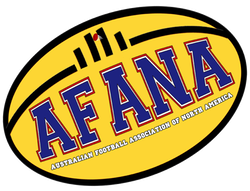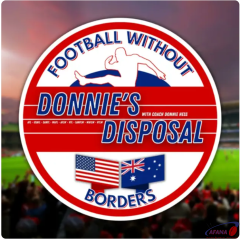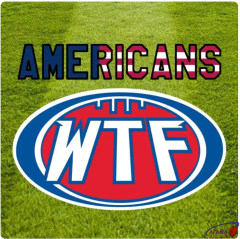Questions and Answers about Australian football or “Aussie rules football”
This is a basic introduction to the sport. You will find answers to some common questions. This won’t make you an expert but it should get you started.
If you don't find the answer here, we have some additional resources:
- Video intros to Aussie rules: http://www.afana.com/footyexplained (a great complement to this page):
- List of “footy” terms: http://www.afana.com/wikis/faq/footy_faq_footy_words_you_need_know-161
- Coffee table guide to footy: http://www.afana.com/aflguide (print this out and keep it as a ready reference for yourself and friends)
- Our more in depth guide to facts about footy: http://www.afana.com/af_faq (when you want more detailed info on the sport)
- The AFL rule book: http://www.afana.com/afl_laws (useful only as a reference, not an easy way to learn the game)
Links to individual questions:
Q1: Isn’t it just like rugby? Soccer? American Football?
Q2: It looks like chaos out there. Do they really have any rules?
Q3: How do you score? What do all those numbers mean?
Q4: Why bother to run around much then, just kick for goals. Wouldn’t that be easier?
Q5: Yea, that field is big, but just how many players are there? It looks like everyone is out there at the same time.
Q6: The TV shows the coaches in the coaching box but they don’t seem to be down at the field except between quarters?
Q7: How much running do the players do in a match?
Q8: Explain the clock to me. Sometimes it seems to be continuously running upwards and other times (like I’d expect), it winds down, stops and starts.
Q9: What’s that bounce thing the umpires do with the ball?
Q10: What penalties are awarded? How many yards or meters?
Q11: They tackle each other and they don’t wear pads! There must be a ton of injuries.
Q12: Why would anyone want to play such a violent sport?
Q13: Explain the AFL to me. Who are the teams and where are they from?
Q14: Wait, there are nine teams in Melbourne?
Q15: Do all those teams have their own home ground? That’s a lot of stadiums (err, stadia).
Q16: What’s the season like? How often do they play and how is the schedule setup?
Q17: What times are the games played?
Q18: Are there divisions or conferences? How do they figure out the standings?
Q19: Who gets to the playoffs?
Q20: With 23 games and 18 teams, that must mean the schedule is unbalanced?
Q21: How much are AFL players making? Millions? Do they have free agents, trades, salary caps, etc.?
Q22: Are players drafted out of college?
Q23: How big is the sport in Australia?
Q24: There is a women's league?
Q: Isn’t it just like rugby? Soccer? American Football?
A: Australian football is not rugby or soccer and has no direct historical link to American football. Please don’t call it rugby and if you hear people saying a former Aussie rules player “does rugby kicks”, let them know (gently) they aren’t up to speed. There is a difference. The sport closest to Aussie rules in terms of history and skills is Gaelic (Irish) football but that's a detour. You will hear the sport referred to as "Aussie rules", "Australian football", "footy", or even (incorrectly) as "AFL".
Q: It looks like chaos out there. Do they really have any rules?
A: Yes, Virginia, there are rules. Lots of ‘em. However, the basics are easily understood. The first thing to keep in mind is that this game is intended to be continuously flowing without constant stoppages. In that sense, ice hockey resembles Aussie rules more than it does any form of football you have seen before. You’ll do much better if you don’t try to interpret the game in terms of American football. Let's also mention what you won't see:
- There is no offside rule. There is no goal keeper. There are no special teams or mass substitutions. Players can be anywhere on the field at any time. There are specific skills that make some players better suited to different offensive and defensive aspects of the game but the rules don't require it.
- There are no "timeouts". Even the umpires cannot stop play unless there is a serious injury, the ball goes out of bounds, or they need to retrieve a tied up ball and restart play. If the ball goes out of bounds ("over the line") or a goal is scored, play stops only long enough for the officials to restart it. It's typically not enough for the TV networks to squeeze in a commercial so all the commercial breaks occur between quarters or pre- or post-game. If you are tired of watching 30 minutes of commercials and pointless chatter while waiting for a few minutes of sport, this is for you. However, the down side is that to make up the revenue, teams have allowed just about every square centimeter of the ground and the players to be plastered with sponsor adverts and logos.
- The players don't wear pads. Head gear is unusual and typically limited to padded head cover similar to amateur boxers but smaller. This is a plus since you can actually see the players and their faces. Everyone has a mouth-guard or eventually you'll have to replace a few teeth.
Another thing you won't see: American style cheerleaders. Most teams have "cheer squads" made up of dedicated fans who do pregame banners and often sit together in the stands. There is no lack of color or enthusiasm on the part of fans. Now on to some things you need to know about how the game is played:
Q: How do you score? What do all those numbers mean?
A:
- Scoring: Goals are six points. There are 4 posts at each end, 2 taller ones in the middle and two shorter ones on the outside and no cross bars. Goals are earned by kicking the ball through the two taller posts at each end. It has to be kicked and cannot be touched by another player before it goes through the posts. It can go through on the air or ground (bouncing or rolling) and cannot touch either post.
- If the ball touches an inner post or goes through the space between the tall and short posts, that’s a “behind” or single point. If another player touches the ball before it goes through the center posts, that’s also a behind. If it touches the outer posts, no points are awarded.
- Scores are indicated with three numbers: goals, behinds, total points. Therefore if I say Hawthorn had 4.5 (29) it means they had 4 goals (6 points each) and 5 behinds (1 point each) and 4x6 + 5x1 = 24 + 5 = 29 points. The team with more points wins, regardless of how they got there. Games in the “regular” or premiership season can end in a tie (called a “draw”). “Postseason” or finals matches have tie-breaking extra time (“overtime”) provisions (two 5 minute periods then sudden death). (Note: Prior to the 2016 season, they used to replay the championship (known as the Grand Final) if it ended in a tie, a week later. Yes, the entire game! That was changed in April, 2016.)
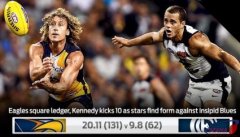
Q: Why bother to run around much then, just kick for goals. Wouldn’t that be easier?
A: Ahh, now we get to some of rules. The first thing is this: the field is HUGE by US or Canadian standards. Typically it is played on a cricket field. For example, a 170m x 135m oval (185 yards by 145 yards). The best players in the AFL can kick the ball about 60 to 65 meters. The primary and preferred way to get the ball down the field is to kick it. The reasons for doing this are simple: if you kick it and another player (on either team) cleanly catches it, they get a free (unimpeded) kick. This is known as a mark. If that player is close enough to score, he gets a free shot at goal. The nearest player from the other team to the kicker has to stand no closer than the point of the catch (on the "mark") and the player taking the kick can back up to get a good shot. Kicks after a mark must go at least 10 meters to allow for another mark. Players can also opt to “play on” if no one is near them and they can run after the catch instead. Sometimes, the umpire directs them to do so, particularly if they are taking too much time (more than 5 or so seconds). If a player takes a mark prior to the siren sounding the end of a quarter or the game, and they are close enough to score, they get to kick the goal after the siren. The other methods to move the ball are to run with it or hand pass it. If you go more than 15 meters, then the ball must touch the ground for at least a split second (you can bounce it or reach down and touch the ball to the ground). The hand pass is similar to the old underhand punch of the ball used in volleyball serves. There is no “throwing” permitted (over or under hand).
x
Q: Yea, that field is big, but just how many players are there? It looks like everyone is out there at the same time.
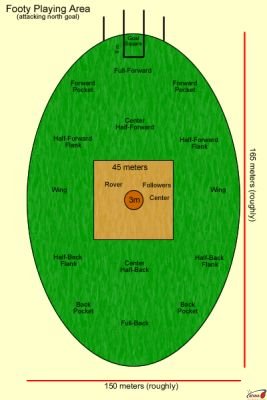
A: Each side in the professional game gets 18 players on the field at a time plus 4 “interchange” or bench players and one emergency substitute. While players have positions, any player can roam anywhere on the field at any time. There are no goalies, and no offside rule (as in soccer). The interchange players can come in and go out at any time during play so long as their team doesn’t have more than 18 on the field at any moment. The substitute can only be activated if another player is removed (e.g. due to injury). The number of interchanges per game is capped at 75. Interchanges can occur at any position. Add in 3 umpires, water carriers, and some “runners” (see below) and the field can look very full on a TV screen but rest assured that given the size of the grounds, there is plenty of room to play. You may also hear the term "emergencies". This refers to players named in addition to the primary 22 for a match. Teams usually have to name the 22 each week two days prior to the match. Should a player become ill or injured after that two day window, they can replace the ill player in the 22 with an emergency player. Beginning in 2019, there will be restrictions on how many players can be in specific areas of the field at center bounces only. The AFLW rules allow 16 women on the field, 5 interchange players, and 60 interchanges per match.
Q: The TV shows the coaches in the coaching box but they don’t seem to be down at the field except between quarters?
A: Unlike in most American sports, the coaches stay primarily in the coach’s box. Spend a little time on the sideline of an amateur match, and you will see why. It’s hard to follow the entire field and all the players from ground level. Even a little elevation helps. That’s what the runners are for; they relay messages from the coaches to the players on the field. On field guidance is also provided by the captains of each club. Each coach has a phone down to the interchange box to relay instructions to the runner and players on the bench. (As of 2019, water carriers cannot be on the field during live play and runners can only enter after goals are scored and must leave prior to the next ball up.)
Q: How much running do the players do in a match?
A: It’s said that AFL players are the most physically fit team sport athletes in the world because they must combine aerobic and anaerobic fitness. The average midfielder in the AFL will run 10 to 12 km in a match (6 to 8 miles).
Q: Explain the clock to me. Sometimes it seems to be continuously running upwards and other times (like I’d expect), it winds down, stops and starts.
A: The game consists of four quarters of 20 minutes of play. In the days before digital timing, this meant that someone roughly kept track of “stoppage” time and as in soccer, the time was added on to the 20 minutes. Only the umpire didn’t tell anyone how much time was being added. Purists still like this way and some TV and radio networks, and even phone apps still do, too. However, the real clock is now kept electronically and the networks and game officials know exactly how much time is left at all times. The coaches presumably do, too. Typically, this is not shown at the ground on the scoreboard so the players don’t know unless a runner tells then. Most matches take between 2:15 hours and 2:45 hours to play in real time. TV viewers, even in Australia, are gradually coming around to the real time wind down clock but some networks will use the real time clock up to the 5 minute mark and then switch to the elapsed time clock. Fox Sports Australia seems to prefer the real time clock while 7 Network prefers the traditional method.
Q: What’s that bounce thing the umpires do with the ball?
A: Think of it like a “tipoff” in basketball. It’s used at the beginning of every quarter and the umpire bounces the ball to start play (known as a "bouncedown"). Whenever the ball is tied up on the ground and neither side has clear possession the umpire will usually just throw it up in the air. This is sometimes referred to as a “ball up”. The two players contesting the opening bounces and ball up are usually the “ruck” players and typically the tallest on the field.
Q: What penalties are awarded? How many yards or meters?
A: The rules of the game provide for a wide range of fouls and penalties. The most typical penalties are for holding the ball (not advancing it or getting it to another player in a timely manner), kicking it out of bounds in the air ("on the full"), pushing another player in the back (hands on the back will be permitted in 2019 but not pushes), contact too high (above the shoulders), etc. This results in a free kick or possession going to the other team. Violations that are more serious or ignoring the directions of the umpires can get you a 50 meter penalty. The most serious violations, particularly ones where there is potential injury to another player, can result in being reported to the AFL tribunal (a judiciary body) and subsequently a fine or suspensions from future games. In most cases, players accept the set fine or suspension for their offense rather than face the tribunal. The game is much less violent and there is vastly less “buffoonery” in the game now than in the past.
Q: They tackle each other and they don’t wear pads! There must be a ton of injuries.
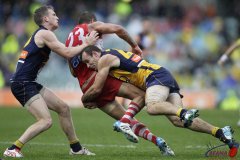
A: Actually, it’s the opposite. The sport has fewer injuries than American football. The players are more athletically fit (no 325 lb. lumbering giants) and they do not intentionally line up and run directly at each other. The lack of padding by itself removes hard surfaces for the opposing player to make contact with during a play. Head (concussion) and knee injuries (ACL) are a concern as in all contact sports. The common perception, due to the few but spectacular collisions shown on television, is that the sport is always like that. That’s an incorrect assumption because most of the time the sport is characterized by lots of running and great catches. Tackling is common and legal but it must be below the shoulders, and above the knees. There is also this one other thing – if you have the ball and are tackled to the ground still in possession of the ball, you lose possession to other team unless you have made an effort to dispose of the ball.
Q: Why would anyone want to play such a violent sport?
A: Again, don’t be fooled by a ten second clip on TV or YouTube. You can watch entire matches and never see anything like that. No doubt about it, this is a physically intensive contact sport but it is also very athletic and entertaining. Oh, and play doesn’t stop every 25 seconds for a minute or so before it begins again.
Q: Explain the AFL to me. Who are the teams and where are they from?
A: The game is played at a professional level only in Australia. The competition evolved out of the Victorian Football League going national in 1987. The old VFL had all of its teams based in Melbourne, Victoria in the southeast corner of Australia. The league is now in every major city in Australia and consists of 18 teams.
The teams, their nicknames, and nearby major city are as follows:
Adelaide: Adelaide Crows, Port Adelaide Power
Brisbane: Brisbane Lions
Geelong (Victoria): Geelong Cats
Gold Coast (Queensland): Gold Coast Suns
Melbourne: Carlton Blues, Collingwood Magpies, Essendon Bombers, Hawthorn Hawks, North Melbourne Kangaroos, Melbourne Demons, Richmond Tigers, St Kilda Saints, Western Bulldogs
Sydney: Sydney Swans, Greater Western Sydney (GWS) Giants
Perth: West Coast Eagles, Fremantle Dockers
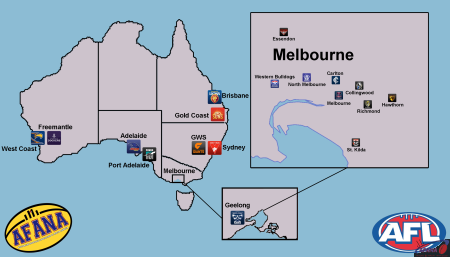
Q: Wait, there are nine teams in Melbourne?
A: Yes. Plus Geelong (just outside Melbourne) which makes ten. This is the legacy of the Victorian Football League (VFL) days. The modern AFL was formed out of the VFL in 1987. It also means that there are more professional sporting clubs in Melbourne than in any other major city in the world. This has resulted in the clubs dividing the fan base, sponsorship, and game revenue in 11 ways (counting the league office itself). It doesn’t take a business genius to see the problems this causes. Thanks to big TV rights revenue, the AFL can and does subsidize many of the clubs with generous prop-up money every year. Without it, the number of clubs in Melbourne would rapidly shrink. Add the fact that the AFL is still underwriting the most recent expansion clubs (Gold Coast and GWS) the extra cash is a big drain on the sport financially. How long it can be sustained isn’t clear. Several clubs were forced into mergers or relocation in the mid 90’s and someday it may happen again. For the clubs outside Melbourne, the travel during the year (7 to 8 long trips per season) is much more arduous than for the Melbourne clubs (2 to 3 long trips per season). At least, for now, TV revenue insures things will stay more or less as they are.
Q: Do all those teams have their own home ground? That’s a lot of stadiums (err, stadia).
A: No, they don’t. A long time ago that was the case, but now all nine Melbourne teams play either at the Melbourne Cricket Ground (MCG) or at Marvel Stadium (formerly Etihad Stadium and Docklands Stadium).

The Perth area clubs share Optus Stadium in Perth. The teams in the Adelaide area play at Adelaide Oval. Brisbane plays at the Brisbane Cricket Ground (or just The Gabba - short for Woolloongabba). Geelong plays at GMHBA Stadium at Kardinia Park (formerly Simonds Stadium). Gold Coast plays at Metricon Stadium in Carrara. The Sydney Swans play at the Sydney Cricket Ground (SCG) and in the recent past at ANZ Stadium (aka the Olympic Stadium). GWS plays at the Sydney Showgrounds Stadium (formerly Spotless Stadium). Assorted other smaller venues are used for various games in other locations around Australia, in Tasmania, and in New Zealand several times a season. In recent seasons, one game has been played in Shanghai, China each year. The shared venues are a mixed bag. It means that many clubs have no real “home field advantage” in most matches (as we would see it in US sport) and they often don’t control their stadium revenue either. This also contributes to the financial problems of many clubs.
Q: What’s the season like? How often do they play and how is the schedule setup?
A: The season currently consists of 1 to 2 preseason matches, 23 regular season matches over 24 weeks with one bye per team, and up to 4 finals matches with a bye week between the regular season and finals. The season is played in the southern hemisphere winter. The main part of the season usually begins in March and ends the last Saturday in September. Teams play every week in between except for their bye week and the byes are spread over 3 or 4 consecutive weeks, usually in June. One other note: unlike in North America, the home team is listed first not second (similar to the practice in soccer). Thus a listing of West Coast vs. Carlton means West Coast is the home team. Look at this season's draw.
Q: What times are the games played?
A: Game times are largely dictated to be convenient for the Australian TV networks and audiences. This means that for those of us in North America, they are about as inconvenient as they can get. There are games on Friday nights, Saturday afternoon, twilight, and night, and Sunday afternoon and twilight, and occasionally on Monday or Thursday. Translated to the time on the east coast of North America, that means very early morning Friday, Friday midnight through to Saturday early morning, and overnight Saturday into Sunday. Things are a bit better as you go west in North America but it is rare for a game to start earlier than 11PM in the east or 8PM in the west of North America. We typically get four live games per week in the US on cable networks and some on tape delay or repeat. The DVR is your friend! All matches are now available live or on-demand via the internet using the AFL's contracted internet service. Our TV listings always give you the times in US/Canadian EST/EDT or if you are registered and logged in at this site, in your local time zone. You don’t have to figure out the schedule, we do it for you at AFANA. Many AFL related smartphone apps also automatically convert the game times wherever you are in the world.
Q: Are there divisions or conferences? How do they figure out the standings?
A: No divisions or conferences. Every club is in one group just like baseball back in the pre-expansion era. The standings (aka table) gives you 4 points for a win, 2 points for a draw (tie), and 0 for a loss. (see Why 4 points? apparently it is historical, no one is sure why.) Don’t confuse these standings “points” for the points scored in matches. The primary tiebreaker is called the percentage. This can be confusing to new fans but it is easy to understand. It’s simply the ratio of the total game points the club scored (all games combined) to the total points their opponents have scored. Therefore, if your team has scored 325 points and the opponents 301, your percentage is the ratio 325 divided by 301 and multiplied times 100 equaling 107.97. The higher the percentage the better. Have a look at this season's current table. (The historical origins of this tie-breaking system is a bit murky but was apparently used in another form after 1896 and in the modern way after 1933. It has it's own quirks where margin of victory can be negated if the total points allowed is higher, e.g. 100 for, 70 against is 143%; 80 for and 53 against, a smaller margin of 27 points, results in a percentage of 151%.)
Q: Who gets to the playoffs?
A: Playoffs are called "finals" and eight teams qualify by position in the standings or ladder. This is the easy part. The format is a bit complicated but here is the simplest explanation we can come up with:
Week 1: The teams seeded 5 through 8 are paired up 5 vs. 8 and 6 vs. 7. These are called Elimination Finals because… you guessed it, the losers are eliminated from the post-season. The top four teams are paired up 1 vs. 4 and 2 vs. 3. These are known as Qualifying Finals since the winners get a week off and advance to Week 3.
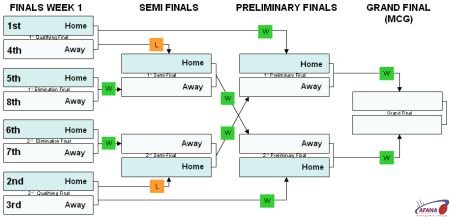
Week 2: The winners of the Elimination Finals and the losers of the Qualifying Finals meet in the Semi-Finals with the higher seeds getting “home” grounds. (Yes, this is a bit of misnomer to Americans since it isn’t the next to last round but there you go.) The two winners advance and the two losers are done for the year.
Week 3: The remaining four teams are paired up in the Preliminary Finals with the Qualifying Finals winners getting home ground and with the proviso, that if any two teams have already met in Weeks 1 or 2 they can’t play in Week 3. The two winners advance to the championship game the following week.
Week 4: The Grand Final. Think of this as the equivalent of the Super Bowl but in relative terms even bigger than that in Australia. The game is always played at the MCG regardless of which teams are in it. Since 1945, only one Grand Final has not been played there and that was due to construction at the MCG that year. It was played at Waverley Park, which no longer exists. This can result in a Melbourne club having home ground advantage against a non-Melbourne club or even two non-Melbourne clubs playing in Melbourne. You might think, based on North American sports, that they would move it around but the VFL influence and tradition is so strong this is unlikely to happen anytime soon. Keep in mind too, that Australia has only four cities of a million or more in population, and only four stadia which hold more than 50,000 people (MCG, ANZ Stadium in Sydney, Optus Stadium in Perth, and Adelaide Oval). The Adelaide Oval and Optus Stadium opened recently. The options for moving the game are much more limited.
Q: With 23 games and 18 teams, that must mean the schedule is unbalanced?
A: Yes, it is. The draw or fixture, as the schedule is known, is not random but rather based on several factors. Certain teams are guaranteed to play each other every year and usually twice. These are the rivalry games (e.g. the two Adelaide teams or the two Perth clubs). There are also certain traditional games (e.g. Collingwood v Essendon on Anzac Day) built in plus games that suit the AFL for attendance or TV reasons (rematches of the Grand Final teams from the previous year). The bulk of the schedule is supposed to follow an equity formula whereby teams are matched up against teams with similar records the previous year to achieve league parity (not unlike the NFL -- and the AFL reportedly uses the same scheduling software). The reality is that with all of the above factors plus travel, stadia availability, and a raft of preferential requests the clubs submit after each season, it means that some clubs get easier draws than other clubs get or play at certain times and never at others. For US and Canadian fans, it affects what we see. For example, the Perth teams rarely play on Friday nights or Saturday early afternoon unless on the road against a Melbourne team. This results in more TV coverage in North America for some AFL clubs than for others. The good news is that with the increased coverage on US TV in recent seasons, this is much less of a problem than it was in the 90’s or 00’s.
Q: How much are AFL players making? Millions? Do they have free agents, trades, salary caps, etc.?
A: Yes to all of that, but not at NFL levels. (US equivalents as of 9/8/19 exchange rates) Salaries (2018) now average about A$362,000 (US$248,000) with about a third over A$400,000 (US$274,000) and 8% or so over A$700,000 (US$479,000). Six players earned over A$1 million (US$684,000) in 2018 according to AFL reports with a top at a rumored A$2,000,000 (US$1,368,000). The league minimum is in the range of A$60,000 (US$41,000) per year . Free agency is limited and players typically have to be at least seven years in the league to be unrestricted free agents. The clubs have salary caps and the cap is now about A$12.5 million (US$8.5 million) per club with some offsets for certain clubs and situations. There is also a league minimum, a bit over 92% of the salary cap in any given year. There are no in-season trades or player movement between teams (starting in 2019, there will be an in-season draft). Trading is confined to specific time windows during the off-season. Each club carries 38 “senior list” players and six “rookie list” and international players. For the AFLW, the women are still considered part-time players and paid between A$13,400 and A$24,600 (US $9,100 to $16,800). Not exactly livable wages but revenue is still low and the league and AFLPA promise improvements.
Q: Are players drafted out of college?
A: No. There is no system comparable to the college system in American football downunder. Players are eligible to be drafted if they are or will be at least 18 years old by December 31st of the calendar year of the draft. Typically, they are drafted directly out of secondary school or lower level leagues. There are actually three annual drafts: the main or national draft, the rookie draft, and the preseason draft (beginning in 2019, also a fourth in-season draft). The preseason draft is a “re-entry” draft for those who were dropped by their club or overlooked in the national draft. The rookie draft is for players to be added to the rookie list. They can join the senior list only if a spot opens up (perhaps due to injury). The big draft is the national draft, typically around the US Thanksgiving, and it is the same sort of big TV event as are the NFL and NBA drafts over here. You can watch it using an online service.
There are also some special rules for “father-son” situations (if the father played over a 100 games with one club it can claim preferential draft rights to his son) (for women in the AFLW there is a father-daughter rule) and for international players. In 2015, for the first time, an American made it to the AFL through this route as Jason Holmes debuted with St Kilda. Holmes, like all of the American players in the pipeline now, are changing from another sport (e.g. college basketball) and not from playing the game in a US or Canadian amateur league. (Holmes was released after the 2017 season having appeared in only 5 games.) In 2018, an American international player, Mason Cox, emerged as a star player for Collingwood and scored three goals in the Grand Final. It was the "sensation" of the season down under. Cox is now past 100 games in his career and by far the most successful American the sport.
Q: How big is the sport in Australia?
A: It's the big gorilla. Consider this: It's the fourth best attended sport (based on average per game of 35,100 [2019]) in the world. In 2023, the total attendance record for the year was set at over 7 million for the year. The domestic TV contract in Australia pays the league more than A$650 million (US$410 million) per year in a country with just 26 million people. Not NFL dollars but pretty good and quite possibly only the NFL and English Premier League do significantly better on a relative basis. From a market share standpoint they are actually more dominant in Australia than the NFL is in the US. It is the biggest sport in Australia, or at least in all but the states of New South Wales and Queensland where rugby has a claim. The equivalent of the Super Bowl, known as the Grand Final, usually draws 90,000+ in attendance and about 1 in 6 Australians watch it. Another way to access popularity is "club memberships". Australian can join their favorite AFL club and thereby get better seats and preferential treatment at finals time. About 1 in 21 Australians have joined an AFL club, over 1,264,000 million total.
Q: There is a women's league?
A: Yes. The AFLW has played seven seasons as of 2022 and is gradually expanding. To date, the season is now played from early September to November with the Grand Final the last week in November with a 10 game regular season and four weeks of post-season aka finals play. The league now has 18 teams (each attached to an AFL club). Players are paid relatively low salaries for a partial year, with the salaries ranging from A$40,000 to $100,000 per year (US$25,000 to 60,000). The league now seams fully established and the AFL is by all appearances committed to its long term success but will require financial support for many more years until match attendances and TV revenue increase substantially.
Article last changed on Wednesday, September 06, 2023 - 10:28 AM EDT
